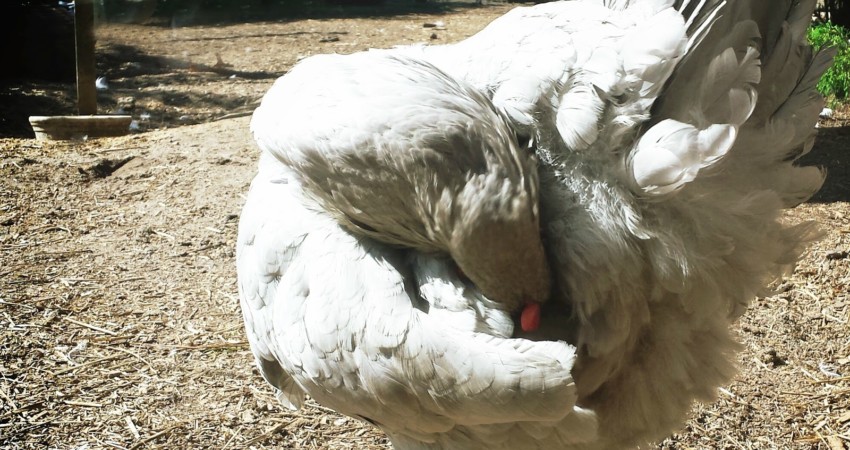

If your chickens are itchin’, it may be possible that you have a mite and/or poultry lice problem on your hands. Mites and lice are external parasites that will move into your coop and onto your chickens, using them as hosts for feeding and breeding activities. Although the life cycle of such parasites is short and averages about a week, during that time they can lay over 100,000 eggs which can pose a real problem if their population is allowed to grow unchecked.
The presence of mites and lice begins with introduction from an outside source. This can be a new bird added to your flock, rodents creeping around the coop, visiting wild birds, or through hitching a ride on the shoes and clothes of a visiting chicken-keeper. They may even find their way onto your shoes and clothing if you visit another flock kept elsewhere that has a mite or lice problem. Once these parasites have arrived, it will not take long before signs of their presence begin to show.
If you notice feather pulling, weight loss, listlessness, pale comb, changes in appetite, decreased egg production, reddened skin, scabs, lifting scales on legs, it is possible that you have a might problem. Another sign is chickens that do not want to go to roost or nest in the coop, as mites and lice are able to live in there as well as on the birds themselves. For visual confirmation, part the feathers of your birds and take a look at the quills and skin, especially around the vent. In many cases, you will be able to see parasites scurrying away. Eggs will also be present.
Preventative measures that can be taken to keep parasites at bay start with regular coop cleaning. Since these creatures can and do live in coops, cleaning and treating nesting areas and roosts will make those environments less appealing.
Pay particular attention to loose feathers as that is where parasite eggs are often laid and they can still hatch even after the feather has left the bird.
When introducing new members to your flock, quarantine them for two weeks before letting them meet other birds. During this time it won’t hurt to do a little parasite prevention on them as well.
Also be sure to limit the equipment you share or loan to other chicken keepers, as these items can become a parasite superhighway for moving bugs back and forth. Secure your feed from rodents and visiting wild birds since those animals can spread parasites as well. Most importantly, however, is providing an area for dust bathing and maintaining access to it.
Dust bathing is a natural way in which chickens repel mites and lice. You can even add natural herbs to your coop as some are naturally anti-parasitic (catnip, fennel, fever few, lavender, rosemary, wormwood, etc.).
If mites and lice manage to invade anyway despite your efforts to keep them away, treatment becomes your only option. When it comes time to treat, you will have to treat every bird in the flock. This is best done in the evening when birds are settling in to roost as they will all be in the same place at the same time and you can keep track of who has been treated. Many means of treatment are available, but which ones you use are entirely up to you. A popular choice is Diatomaceous Earth (DE) which has bug-killing properties but also may cause respiratory issues, so read instructions thoroughly and use this at your own risk while practicing safe handling.
Other choices include Poultry Protector, Pyrethrum Dust, Sevin Dust (5%), Ivermectin, and dog flea shampoos/dips. You can also make a homemade spray that includes essential oils (one teaspoon of one of the following: bay, cinnamon, clove, coriander, lavender, spearmint, tea tree, thyme) mixed with on ounce of garlic juice and water. Adding garlic to water is said to be useful as well as makes chickens less appetizing. For scaly leg mites, spray them down and slather in Vaseline to suffocate mites. If you are uncertain as to which is best for use in your coop, consult an avian vet. When treatment begins, keep in mind that it must continue long enough to kill unhatched nits when they emerge, which generally means re-treating a couple of times over the course of a couple weeks.
Be sure to treat both chickens and coops simultaneously to solve mite and lice problems. Also beneficial during this time is providing foods rich in iron to combat parasite related anemia, such as broccoli, collards, cornmeal, dandelion greens, eggs, kale, meat, molasses and oatmeal. Pay special attention as well to broody hens as they may not leave the nesting area to dust bathe. The prompt treatment and eradication of mites and lice is important as infestations can lead to anemia and even death. If you notice the presence of parasites, it is time to get out there and do what it takes to stop those chickens from itchin’.
 Contact Jaguza Support
Contact Jaguza Support